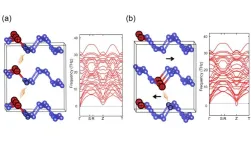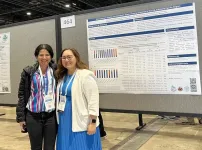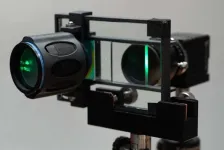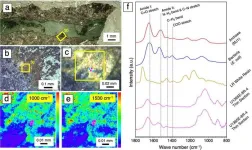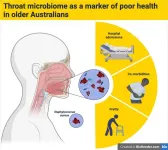(Press-News.org) New research by Curtin University has achieved a breakthrough in eco-friendly display technology, creating highly efficient and stable blue quantum dot LEDs (QLEDs) that could power the next generation of televisions, smartphones, VR headsets and energy-efficient lighting - without using toxic heavy metals.
Study author Associate Professor Guohua Jia from Curtin’s School of Molecular and Life Sciences said QLEDs are a futuristic display technology known for their superior brightness, colour accuracy, lifetime and energy efficiency compared to traditional LEDs. However, creating stable and efficient blue QLEDs without toxic materials like cadmium had until now been a major challenge.
“Our research team has developed a new type of quantum dot that matches or even outperforms traditional cadmium-based QLEDs, but in a safer and more sustainable way,” Associate Professor Jia said.
“Our quantum dots emit a pure and vibrant blue light with an impressive 24.7 per cent efficiency, which is among the highest recorded for blue QLEDs.
“They also last for nearly 30,000 hours, making them a promising step toward more durable and environmentally friendly display technology.”
Associate Professor Jia said the researchers achieved this by fine-tuning the structure of the quantum dots at an atomic level, reducing defects that can interfere with light emission.
“This approach allowed us to create more uniform quantum dots, improving both brightness and stability,” Associate Professor Jia said.
“We believe that our study will have a profound impact across the breadth of devices known as optoelectronics, which either produce light or use light to perform their functions.
“These results represent a new frontier in display technology and put us on a path towards superior displays with high colour purity, operational stability and eco-friendliness.
The study was conducted in collaboration with researchers from Shanghai University, Jilin University, Chinese Academy of Sciences, Fudan University and TCL Research.
The full study titled ‘Homogeneous ZnSeTeS quantum dots for efficient and stable pure-blue LEDs’ was published in the prestigious journal Nature and can be found online here (DOI: 10.1038/s41586-025-08645-4).
END
Quantum dot discovery for LEDs brings brighter, more eco-friendly displays
n/a
2025-03-06
ELSE PRESS RELEASES FROM THIS DATE:
Phosphorus doping stabilizes high-energy polymeric nitrogen at ambient pressure
2025-03-06
Using first-principles calculations, a research group led by Prof. WANG Xianlong from the Hefei Institutes of Physical Science of the Chinese Academy of Sciences, found that phosphorus doping is an effective way to achieve high-energy polymeric nitrogen with black-phosphorus structure (BP-N) stable at ambient pressure.
The research results were published in Matter and Radiation at Extremes.
Cubic gauche nitrogen with diamond-like structure and BP-N with black phosphorus structure, represented by polymeric all-nitrogen materials, are a class of high-energy density materials composed entirely of N-N single bonds, but their samples ...
Maternal cannabis use triples risk of disruptive behaviour in children
2025-03-06
Children exposed to their mother’s cannabis use during pregnancy and after birth are three times more likely to develop behavioural problems, new Curtin University research has found.
Published in Psychiatry Research, the study analysed data from more than 222,600 Australian mothers and children, revealing maternal cannabis use disorder (CUD) during pregnancy and the postnatal period significantly increased the risk of childhood disruptive behavioural disorders.
Lead researcher Abay Tadesse, from Curtin’s School of Population ...
Balancing Nutrition: Micronutrient study could help prevent childhood obesity in Pacific region
2025-03-06
Children ages two to eight years across 11 Pacific jurisdictions (Alaska, American Samoa, Commonwealth of the Northern Mariana Islands, Federated States of Micronesia, Guam, Hawai‘i, Marshall Islands, and Palau) are not meeting daily recommended intakes for key micronutrients, either consuming too much or too little. That discovery was published recently in a study led by scientists at the University of Hawai‘i (UH) at Mānoa. The research team also found associations between children’s micronutrient intake, obesity, and presence of acanthosis nigricans, a skin condition that is ...
Lightening the load of augmented reality glasses
2025-03-06
An international team of scientists developed augmented reality glasses with technology to receive images beamed from a projector, to resolve some of the existing limitations of such glasses, such as their weight and bulk. The team’s research is being presented at the IEEE VR conference in Saint-Malo, France, in March 2025.
Augmented reality (AR) technology, which overlays digital information and virtual objects on an image of the real world viewed through a device’s viewfinder or electronic display, has gained traction in recent years with popular gaming apps like Pokémon Go, and real-world applications in areas including education, manufacturing, ...
Sneaky clocks: uncovering Einstein’s relativity in an interacting atomic playground
2025-03-06
For over a century, physicists have grappled with one of the most profound questions in science: How do the rules of quantum mechanics, which govern the smallest particles, fit with the laws of general relativity, which describe the universe on the largest scales?
The optical lattice clock, one of the most precise timekeeping devices, is becoming a powerful tool used to tackle this great challenge. Within an optical lattice clock, atoms are trapped in a “lattice” potential formed by laser beams and are manipulated with precise control of quantum coherence and interactions governed by quantum mechanics. Simultaneously, ...
The chances of anything coming from Mars
2025-03-06
Within the next decade, space agencies plan to bring samples of rock from Mars to Earth for study. Of concern is the possibility these samples contain life, which could have unforeseen consequences. Therefore, researchers in this field strive to create methods to detect life. For the first time, researchers, including those from the University of Tokyo and NASA, successfully demonstrated a method to detect life in ancient rocks analogous to those found on Mars.
We’ve all seen the movies, in which “Scientists bring back something from space, ...
Scientists unlock clues to new treatments for muscular dystrophy
2025-03-06
A new discovery about how tiny protein clusters form in cells could pave the way for treatments for Emery-Dreifuss muscular dystrophy (EDMD), a rare genetic disorder that causes muscle weakness and heart problems.
Researchers at the USC Dornsife College of Letters, Arts and Sciences combined advanced imaging techniques and theoretical physics to observe and explain how nanoclusters of the protein emerin form inside living cells. These clusters — about 100,000 times smaller than a human hair’s width — play a crucial role in how cells sense and respond to mechanical forces like stretching or pressure, ...
Anti-obesity drugs benefit kidney transplant recipients with type 2 diabetes
2025-03-06
Kidney transplant recipients with type 2 diabetes treated with a new class of anti-obesity drugs were less likely to experience organ failure and survived longer, a new study shows. Not only is obesity a known risk factor for diabetes, but it also increases risk of postsurgical complications, such as inflammation, organ rejection, and early death.
Previous research had suggested some benefit for kidney transplant recipients with a history of type 2 diabetes who took the medications, originally designed to treat diabetes, at some point after their transplant ...
Cases of Parkinson’s disease set to reach 25 million worldwide by 2050
2025-03-06
By 2050, there will be 25.2 million people living with Parkinson’s disease worldwide (a 112% increase from 2021), largely due to population ageing, suggests a modelling study published by The BMJ today.
Overall, the number of people living with Parkinson’s disease (all age prevalence) per 100,000 population is predicted to increase by 76%, and by 55% when corrected for age differences (age standardised prevalence), with rates projected to be highest in East Asia.
The researchers say these projections “could serve as an aid in promoting health research, ...
Throat microbiome holds clues to older Australians’ health
2025-03-06
New research by Flinders University has uncovered a potential marker that could provide valuable insights into the overall health of older adults living in long-term aged care facilities.
Led by PhD candidate Sophie Miller in the College of Medicine and Public Health, the study found that a simple swab from the back of the throat, known as the oropharynx, may offer clues about health challenges faced by aged care residents.
“Our findings suggest that certain bacteria detected in the back of the throat could indicate greater health vulnerability in older adults,” says Miller.
Identifying vulnerable individuals ...
LAST 30 PRESS RELEASES:
Making lighter work of calculating fluid and heat flow
Normalizing blood sugar can halve heart attack risk
Lowering blood sugar cuts heart attack risk in people with prediabetes
Study links genetic variants to risk of blinding eye disease in premature infants
Non-opioid ‘pain sponge’ therapy halts cartilage degeneration and relieves chronic pain
AI can pick up cultural values by mimicking how kids learn
China’s ecological redlines offer fast track to 30 x 30 global conservation goal
Invisible indoor threats: emerging household contaminants and their growing risks to human health
Adding antibody treatment to chemo boosts outcomes for children with rare cancer
Germline pathogenic variants among women without a history of breast cancer
Tanning beds triple melanoma risk, potentially causing broad DNA damage
Unique bond identified as key to viral infection speed
Indoor tanning makes youthful skin much older on a genetic level
Mouse model sheds new light on the causes and potential solutions to human GI problems linked to muscular dystrophy
The Journal of Nuclear Medicine ahead-of-print tip sheet: December 12, 2025
Smarter tools for peering into the microscopic world
Applications open for funding to conduct research in the Kinsey Institute archives
Global measure underestimates the severity of food insecurity
Child survivors of critical illness are missing out on timely follow up care
Risk-based vs annual breast cancer screening / the WISDOM randomized clinical trial
University of Toronto launches Electric Vehicle Innovation Ontario to accelerate advanced EV technologies and build Canada’s innovation advantage
Early relapse predicts poor outcomes in aggressive blood cancer
American College of Lifestyle Medicine applauds two CMS models aligned with lifestyle medicine practice and reimbursement
Clinical trial finds cannabis use not a barrier to quitting nicotine vaping
Supplemental nutrition assistance program policies and food insecurity
Switching immune cells to “night mode” could limit damage after a heart attack, study suggests
URI-based Global RIghts Project report spotlights continued troubling trends in worldwide inhumane treatment
Neutrophils are less aggressive at night, explaining why nighttime heart attacks cause less damage than daytime events
Menopausal hormone therapy may not pose breast cancer risk for women with BRCA mutations
Mobile health tool may improve quality of life for adolescent and young adult breast cancer survivors
[Press-News.org] Quantum dot discovery for LEDs brings brighter, more eco-friendly displaysn/a
